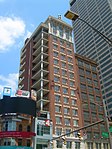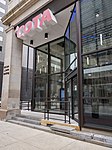Hayden Building (Columbus, Ohio)
1869 establishments in OhioAC with 0 elementsBank buildings on the National Register of Historic Places in OhioBuildings in downtown Columbus, OhioColumbus, Ohio building and structure stubs ... and 4 more
Columbus metropolitan area, Ohio Registered Historic Place stubsCommercial buildings completed in 1869Italianate architecture in OhioNational Register of Historic Places in Columbus, Ohio

The Hayden Building, also known as the Hayden-Clinton Bank Building, is a historic building on Capitol Square in Downtown Columbus, Ohio. It was listed on the National Register of Historic Places in 2009. Built in 1869, it is one of the oldest remaining commercial buildings on Capitol Square. It was designed by Nathan Kelley, one of the architects of the Ohio Statehouse.
Excerpt from the Wikipedia article Hayden Building (Columbus, Ohio) (License: CC BY-SA 3.0, Authors, Images).Hayden Building (Columbus, Ohio)
East Broad Street, Columbus
Geographical coordinates (GPS) Address External links Nearby Places Show on map
Geographical coordinates (GPS)
| Latitude | Longitude |
|---|---|
| N 39.9626 ° | E -82.999958055556 ° |
Address
Hayden Building
East Broad Street 20
43215 Columbus
Ohio, United States
Open on Google Maps










